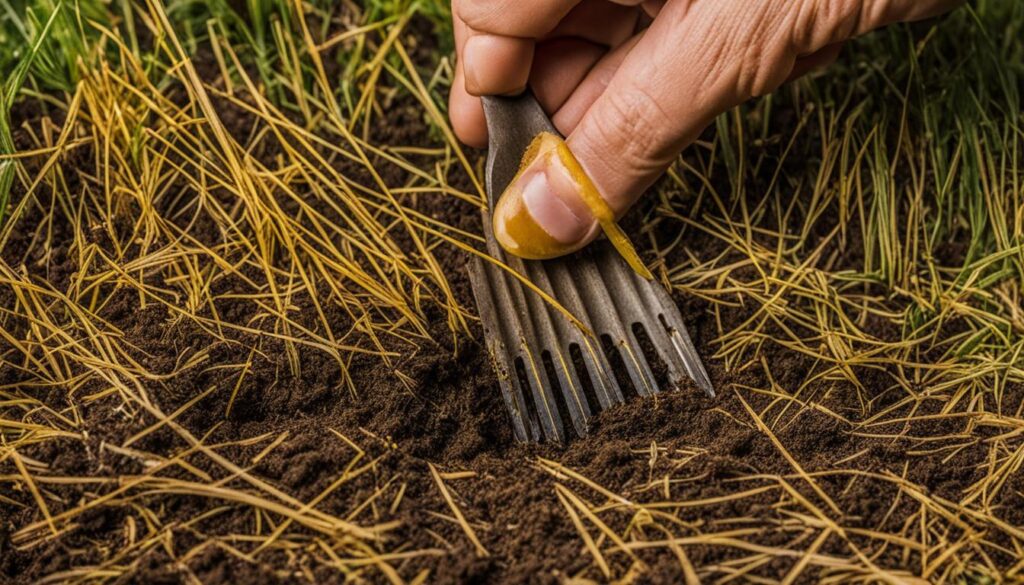If you have unsightly dog pee spots on your lawn, don’t worry – they can be repaired. Dog urine contains a form of nitrogen that can damage your grass if it’s concentrated in a small area. The damage usually appears as brown or dark green spots in the areas where your dog frequently eliminates. Reseeding and soil cleansing treatments can help restore your lawn. You can also consider using urine-resistant grass types to prevent future damage.
Understanding Dog Urine Damage
Dog urine damage is caused by the high concentration of nitrogen in the urine. When a dog pees in the same spot repeatedly, too much nitrogen is transferred to the soil, which can “burn” the grass and kill it. This leads to the formation of brown spots. However, if your soil lacks nitrogen in general, dog urine can act as a fertilizer and result in dark green spots.
Understanding the causes and appearance of dog urine damage is important for effective repairs. By identifying the causes of dog urine damage, such as the nitrogen transfer to soil, homeowners can take the necessary steps to address the issue. It is also essential to comprehend why dog pee kills grass and why it manifests as brown spots from dog urine or dark green spots from dog urine.
To help visualize the effects of dog urine on your lawn, take a look at the image below:
Understanding dog urine damage is the first step towards repairing and preventing it. In the following sections, we will explore various solutions to repair dog pee spots, including reseeding and soil cleansing treatments, as well as preventive measures to keep your lawn healthy and vibrant.
Reseeding Dog Pee Spots
Reseeding is an effective method to repair dead grass caused by dog urine spots on your lawn. To reseed dog pee spots and restore the lush greenery, follow these step-by-step instructions:
- Rake the brown patch: Start by raking the affected area to remove the dead grass and any debris. This will create a clean surface for the new grass seeds to take root.
- Flush away excess nitrogen: Thoroughly water the spot to flush away the excess nitrogen from the dog urine. This dilution helps prevent further damage and prepares the soil for the reseeding process.
- Prepare the soil: Loosen the soil in the affected area with a garden rake or a hand tiller. This step improves the soil’s ability to absorb water and nutrients, aiding the growth of the new grass.
- Choose grass seeds: Select grass seeds that are suitable for your lawn’s conditions, such as sun or shade. Consider using a seed mix specifically designed for repairing damaged areas.
- Apply the grass seeds: Cover the dog pee spot with a mixture of garden topsoil and peat moss. Generously sprinkle the selected grass seeds over the prepared area for even coverage.
- Water newly seeded grass: After seeding, water the area regularly to keep the soil moist. Avoid overwatering, as it may cause the seeds to wash away or promote the growth of weeds.
Continue watering the newly seeded grass daily for a few weeks until it begins to establish its roots. During this time, avoid walking on the new grass as it may disrupt the germination process. Patience and proper care will help your lawn thrive again, free from dog pee spots.
Soil Cleansing Treatments
If the spots in your lawn are yellow and not completely dead, soil cleansing treatments may be effective in saving the grass without the need for reseeding. There are soil-cleansing products available in the market specifically designed for dog urine spots. These products help neutralize excess nitrogen and salts in the soil, allowing the grass to recover. It’s important to choose the right product and follow the instructions carefully.
Using lawn treatments for dog urine spots can effectively address the issue of yellow grass caused by dog urine. These soil-cleansing products are specifically formulated to treat the damage caused by dog urine, removing excess nitrogen and salts from the soil.
By treating yellow grass from dog urine with soil-cleansing products, you can avoid the hassle of reseeding. These treatments target the root cause of the issue, improving the health of the soil and allowing the grass to regain its natural green color.
Preventing Dog Urine Damage
Prevention is key when it comes to protecting your lawn from dog urine damage. By taking a few simple steps, you can minimize the impact and maintain a healthy, green lawn.
One effective way to prevent dog urine damage is by watering the pee spots immediately after your dog eliminates. This helps dilute the concentration of nitrogen in the urine and reduces the impact on the grass. Remember, the sooner you water the area, the better.
Another strategy is to designate a specific elimination area for your dog. This can be a mulched or graveled spot where the damage can be confined. By training your dog to use this designated area, you can minimize the impact on the rest of your lawn.
Maintaining a longer grass length can also make your lawn more resistant to dog urine damage. Longer grass blades provide a greater surface area for the urine to spread, reducing the concentration of nitrogen in a particular area.
Consider incorporating dietary supplements into your dog’s diet. Certain supplements can help reduce the nitrogen content in their urine, limiting the damage caused to your lawn. Consult with your veterinarian to determine the most suitable dietary supplement for your dog.
Additionally, installing a fence around your property can prevent damage from neighbor’s dogs. This not only helps protect your lawn but also provides a clear boundary for your dog’s elimination area.
By following these preventive measures, you can maintain a beautiful and healthy lawn while minimizing the impact of dog urine damage.
What Are Some Quick Fixes for Dog Urine Spots on the Lawn?
To eliminate dog urine spots on your lawn, try watering the area immediately after your dog urinates to dilute the urine. You can also try applying a layer of topsoil to the affected areas, or using a commercial product designed to neutralize the odor and restore the green color of the grass.
Conclusion
In conclusion, if you’re dealing with dog pee spots on your lawn, there are effective solutions to repair the damage and maintain a healthy and beautiful lawn. Whether you choose to reseed the affected areas or opt for soil cleansing treatments, taking action is key to restoring the vitality of your grass.
By understanding the causes of dog urine damage and implementing preventative measures, you can minimize future occurrences. Consider using urine-resistant grass types, which are specifically bred to be more resistant to the damaging effects of dog urine. Additionally, following proper lawn care practices such as regular watering, mowing, and fertilization can help maintain a healthy lawn that is better prepared to withstand dog urine.
Remember, prevention is always better than cure. By designating a specific area for your dog to eliminate, watering the pee spots immediately after your dog urinates, and providing dietary supplements to reduce the nitrogen content, you can prevent extensive damage to your lawn. Installing a fence around your property is also a great way to keep neighbor’s dogs away and protect your lawn.
With a little extra effort and knowledge, you can repair dog pee spots, maintain a healthy lawn, and prevent dog urine damage. Follow these tips, choose the right grass types, and implement preventive measures for a lawn that is vibrant, green, and free from dog pee spots.










